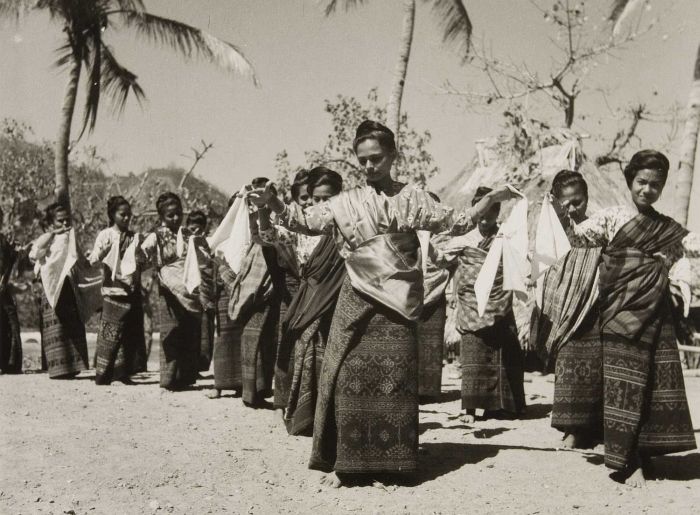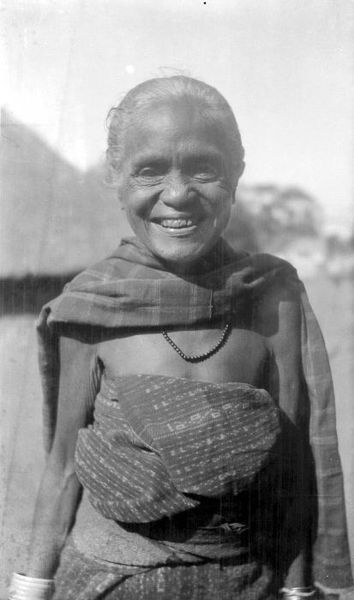“On the Indonesian island of Flores, these ladies have been famous for centuries. Known as Ebu Gogo, which means Granny Flesheater, they are small, hairy, elf-like creatures who live in caves in the forests,” writes author Nury Vittachi in an article from Reader’s Digest Asia in 2008.
Although the term “Granny Flesheater” may have been a tad dramatic and somewhat inaccurate, this does not make the legend any less sensational. Further research reveals more fascinating stories. Legends about the Ebu Gogo go back to early western exploration of Flores by the Portuguese in 1511 CE, who heard that there was a tribe of wild men and women who stole food and kidnapped children. The female Ebu Gogo were said to have had extremely pendulous breasts—long enough, in fact, that they would throw them over their shoulders. They murmured at each other and could repeat words spoken by villagers verbatim. They could climb slender-girthed trees but were never seen holding stone tools or anything similar to do so. Another fantastic attribute of Ebu Gogo was their reputed ability to swallow things whole, including rice mortars, puppy dogs, piglets and small children.

The Island of Flores is one of the island provinces in Indonesia. Three major tribes of Flores are Nagekeo, Bajawa, and Riung. Each of these tribes has their own traditions that have survived for hundreds of years and still practiced to this day.
For generations, the natives of Flores, particularly the Nagekeo tribe, told a story of an isolated tribe of around fifty “small people” inhabiting a cave near one of the island’s volcanoes just outside the old village of ‘Ua. The small people were said to be like humans: they walked erect, albeit awkwardly, and did not have tails, but were covered in hair. Their faces were said to resemble a monkey or an orang utan (“forest person”), with large canine teeth. Although they were short, they were exceptionally strong and very powerful runners. They never used tools or weapons, and they never used fire, preferring instead to eat their food raw. For many generations, they lived alongside the villagers without ever interacting with them until, slowly, the small people started to go into the villages.

As was customary at the time, the people of Flores held celebrations, whether for rituals or merely to entertain themselves. To get to know them better, the villagers invited their small neighbors to participate. At the celebration, the small people danced and laughed in their own peculiar language, eating and drinking to their hearts content. They ate so much and so indiscriminately that, for their own safety, the villagers had to stop them from randomly picking up sharp objects to eat. Amused, the villagers nicknamed them Ebu Gogo (“Grandmother who Eats Everything”).
It is unclear whether the term ebu (“grandmother”) was used as a term of respect, or instead, in the eyes of the natives, their appearance resembled what they imagined to be their grandmothers or their ancestors. Evidently the locals made no distinction of the genders of the creatures and referred to them with a female honorific. However, this seemingly idyllic friendship did not last long as the group of Ebu Gogo started to steal the crops and animals from the village. Despite the villagers’ best attempts to keep the peace, Ebu Gogo went on to raid the village.
Ebu Gogo eventually went too far by kidnapping and consuming an infant from the village. To retaliate, the villagers raised bales of grass onto bamboo poles and delivered them to the Ebu Gogo under the guise of another gesture of friendship. However, the smoldering coals that the villagers had hidden in the last bale erupted in flames, setting off the other bales and, consequently, the entire cave on fire.
Another, more sympathetic version of the story says that Ebu Gogo kidnapped a child in hopes that the child could teach them how to cook. However, all versions include a fire in a cave that killed almost all of the Ebu Gogo. Some legends say that not a single Ebu Gogo survived, while others recount at least two escaping; one male and one female. The last time the central Florinese villagers had seen the creatures is specified as “just before Dutch colonists settled that part of Flores in the 19th century”.
For some people, Ebu Gogo resemble characters that are generally considered to belong to myth and fantasy. Social anthropologists have been inclined to dismiss Ebu Gogo simply as products of the local imagination, or as “spiritual beings”. Indeed, Ebu Gogo seem only slightly different from the various categories of spirits that the locals describe with credulity. The term “pendulous breasts”, for example, is traditionally used for many antagonistic female creatures or spirits in the region. Javanese mythology also has female supernatural beings with pendulous breasts who kidnap children. The being is called Wewe Gombel, and is traditionally represented as a woman with long, hanging breasts and vampire-like fangs. Sundanese folklore says that Wewe Gombel dwells in the crown of the Arenga Pinnata palm, where she keeps the children she catches. However, instead of eating them, she treats the children lovingly as a grandmother would, taking care of them and protecting them until their parents repent for neglecting them, at which point she returns them. The Malaysian Hantu Kopek (“Breast Ghost”, another female entity with pendulous breasts) has a similar habit of abducting children, but she also does not harm them.
The Nagekeo people themselves distinguish Ebu Gogo from “spirits” explicitly with reference to the creature’s lack of extraordinary powers such as, for example, the ability to disappear, change shape, or transform into animals. However, Wewe Gombel and Hantu Kopek also do not have any of these abilities.
In 2003, a fossil of an unidentified hominin creature was discovered in Liang Bua, Flores. On initial examination, the team of archaeologists suspected that, given its small stature, it could have been a young child. However, the permanent teeth indicated otherwise. This creature was definitely an adult at the time of her death; she was a 30-year-old female.

Further searches led to more fossil remains which indicated that the woman, as well as others, were only about 3 feet, 6 inches (106.68 cm) in height. They had comparatively smaller brains than the average adult Homo sapiens, no chins, receding foreheads and proportionally large feet because of their short legs. Given the creature’s physical attributes, the Flores excavation team called them “Hobbits”. The following year, the team published their findings formally recognizing the species as Homo floresiensis.
One of the reasons why Ebu Gogo was considered as nothing more than a local folktale was because the idea of them coexisting with humans was viewed to be a remote possibility. However, the discovery of Homo floresiensis threw this notion of coexistence with Ebu Gogo into a new perspective. Not only did this new species add to the past diversity of the hominin findings, its fossil date of only 13,000 years meant that it would have coexisted quite recently with members of modern Homo sapiens— our own species. Furthermore, it raised the very real possibility that this species might have persisted into the present day.
This discovery also leads to its possible relationships with other creatures found in Southeast Asia. Paleoanthropologist Chris Stringer, of the British Museum of Natural History says, “one of the first things I thought of, on learning about the Flores skeleton, was a possible parallel with the orang pendek.” The orang pendek (“short person”) is a possible relict hominoid in Malaysia. Since hearing accounts of the Ebu Gogo, geochronologist Bert Roberts thinks it possible that Homo floresiensis still stalks the mountain forests of Flores to this day.
Between the mix of human and chimpanzee-like traits in the skeleton of Homo floresiensis and the species’ small frame, the exact placement of the “hobbit” into a hominin category has been debated since it was found. Given the shape of their bodies and the presence of sophisticated stone tools in association with the species, they have been placed into the Homo genus. However, researchers are not in agreement about why the species looks the way it does. Some have put forward theories about microcephaly (abnormal smallness of the head, a congenital condition associated with incomplete brain development), iodine deficiency, and thyroid issues that could have resulted in the small brains and small bodies.

Others see a link between Homo erectus, the species that Homo sapiens likely evolved from, and the “hobbits” through an evolutionary mechanism known as insular dwarfism. The logic here is that Flores is a small island and therefore has limited natural resources. Insular dwarfism can happen when individuals with smaller bodies, and therefore smaller metabolic needs, flourish in a rather difficult environment, leading to smaller and smaller individuals over generations. It is possible, therefore, that a group of Homo erectus that have found their way to Flores evolved through insular dwarfism into Homo floresiensis.
There was another surprise in 2010 when genetic analysis revealed a previously unknown species, the Denisovans, living in Siberia around 40,000 years ago. Little is known of the precise anatomical features of the Denisovans, since the only physical remains discovered thus far are a finger bone, two teeth and a toe bone. These creatures also had large teeth and lived side by side with modern humans and Neanderthals. The single finger bone is unusually broad, well outside the variation seen in modern people. The finger bone belonged to a female, indicating that the Denisovans were extremely robust.
Another creature with similar features was discovered in the Red Deer Cave site in China, in sediments with dates spanning 14,500 to only 11,500 years ago.
These legends sound like they could refer to Homo floresiensis. Indeed, the spread of Denisovans may have included Flores. Research author Thomas Sutikna and colleagues write that, “Whether Homo floresiensis survived after 50,000 years ago – potentially encountering modern humans on Flores or other hominins dispersing through southeast Asia, such as Denisovans – is an open question.”

